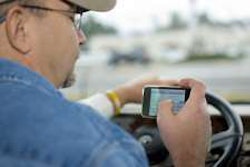Carriers with active policies prohibiting cell phone use and other distracted driving behaviors are successful in reducing distracted driving accidents, Don Osterberg of Schneider National told the U.S. Department of Transportation’s National Distracted Driving Summit Sept. 21 in Washington, D.C.
“At Schneider National and, in general, in the trucking industry, we were focused on distracted driving long before the public rhetoric became the invoked subject it is today,” said Osterberg, senior vice president.
In 2003 Schneider National examined its high-severity crashes and found that well over half resulted from distracted driving activities. That year the company prohibited cell-phone use while driving by drivers, Osterberg said. The policy has been updated to cover both hand-held and hands-free devices.
The carrier follows policies that reduce distractions. For one, a driver manager would never call a driver when the truck is moving, Osterberg said.
For another, he said Schneider’s customer service wants a driver’s cell phone number to contact the driver if it appears a load is running late. “No. We don’t want to call drivers when they’re driving,” he said. The carrier also encourages family members not to call the driver when driving.

“Even in driver recruiting, if it’s clear the driver is on a cell phone, the recruiter says, ‘When you find a safe place to park, call me back,’ ” Osterberg said.
When it comes to safety, “The number one pre-condition and the only guarantor I’ve found for sustainable safety performance is to create a true culture of safety.”
Osterberg made a pitch for better technology. “Let’s put a device in the truck to detect the cell signal because, if I can detect it, I can measure it and intervene to change those beliefs and ultimately those behaviors,” he said.
Robert Rivkin, general counsel for the DOT, asked, “How do we integrate technology into the vehicle so that it supports the driver in keeping eyes on the road and hands on the wheel, and also how can we combine laws and regulations and high visibility enforcement and driver education? We’re not waiting for a magic bullet. We know where we have to focus our attention generally.”
Dr. Linda Angell, research scientist at the Virginia Tech Transportation Institute, said the two key factors regarding driver technology are to integrate basic driver connections in a way that minimizes distractions and to add advanced technologies that do the same.












